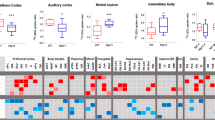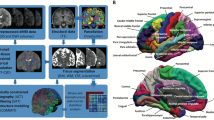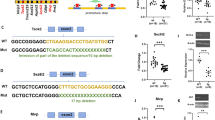Abstract
16p11.2 rearrangements are associated with developmental delay, cognitive impairment, autism spectrum disorder, behavioral problems (especially attention-deficit hyperactivity disorder), seizures, obesity, dysmorphic features, and abnormal head size. In addition, congenital anomalies and abnormal brain findings were frequently observed in patients with these rearrangements. We identified and performed a detailed microarray, phenotypic, and radiological characterization of three new patients with 16p11.2 rearrangements: two deletion patients and one patient with the reciprocal duplication. All patients have a heterozygous loss (deletion) or gain (duplication) corresponding to chromosomal coordinates (chr16: 29 528 190–30 107 184) with a minimal size of 579 kb. The deletion patients had language delay and learning disabilities and one met criteria for pervasive developmental disorder not otherwise specified. The duplication patient received a diagnosis of autism and had academic deficits and behavioral problems. The patients with deletion had long cervicothoracic syringomyelia and the duplication patient had long thoracolumbar syringomyelia. The syringomyelia in one patient with deletion was associated with Chiari malformation. Our findings highlight the broad spectrum of clinical and neurological manifestations in patients with 16p11.2 rearrangements. Our observation suggests that genes (or a single gene) within the implicated interval have significant roles in the pathogenesis of syringomyelia. A more comprehensive and systematic research is warranted to study the frequency and spectrum of malformations in the central nervous system in these patients.
Similar content being viewed by others
Log in or create a free account to read this content
Gain free access to this article, as well as selected content from this journal and more on nature.com
or
References
Weiss LA, Shen Y, Korn JM et al: Association between microdeletion and microduplication at 16p11.2 and autism. N Engl J Med 2008; 358: 667–675.
Kumar RA, KaraMohamed S, Sudi J et al: Recurrent 16p11.2 microdeletions in autism. Hum Mol Genet 2008; 17: 628–638.
McCarthy SE, Makarov V, Kirov G et al: Microduplications of 16p11.2 are associated with schizophrenia. Nat Genet 2009; 41: 1223–1227.
Shinawi M, Liu P, Kang SH et al: Recurrent reciprocal 16p11.2 rearrangements associated with global developmental delay, behavioral problems, dysmorphism, epilepsy, and abnormal head size. J Med Genet 2009; 47: 332–341.
Shimojima K, Inoue T, Fujii Y, Ohno K, Yamamoto T : A familial 593-kb microdeletion of 16p11.2 associated with mental retardation and hemivertebrae. Eur J Med Genet 2009; 52: 433–435.
Walters RG, Jacquemont S, Valsesia A et al: A new highly penetrant form of obesity due to deletions on chromosome 16p11.2. Nature 2010; 463: 671–675.
Speer MC, Enterline DS, Mehltretter L et al: Type I malformation with or without syringomyelia: prevalence and genetics. J Genet Couns 2003; 12: 297–311.
Zakeri A, Glasauer FE, Egnatchik JG : Familial syringomyelia: case report and review of the literature. Surg Neurol 1995; 44: 48–53.
Speer MC, Gerge TM, Enterline DS, Franklin A, Wolpert CM, Milhorat TH : A genetic hypothesis for Chiari I malformation with or without syringomyelia. Neurosurg Focus 2000; 8: E12.
Boyles AL, Enterline DS, Hammock PH et al: Phenotypic definition of Chiari type I malformation coupled with high-density SNP genome screen shows significant evidence for linkage to regions on chromosomes 9 and 15. Am J Med Genet A 2006; 140: 2776–2785.
Ou Z, Kang SH, Shaw CA et al: Bacterial artificial chromosome-emulation oligonucleotide arrays for targeted clinical array-comparative genomic hybridization analyses. Genet Med 2008; 10: 278–289.
Shiow LR, Paris K, Akana MC, Cyster JG, Sorensen RU, Puck JM : Severe combined immunodeficiency (SCID) and attention deficit hyperactivity disorder (ADHD) associated with a Coronin-1A mutation and a chromosome 16p11.2 deletion. Clin Immunol 2009; 131: 24–30.
Acknowledgements
We thank the patients and parents for their willingness to participate in our research study. We thank Ms Morgan Lasala for assistance in recruiting the patients to this study.
Author information
Authors and Affiliations
Corresponding author
Ethics declarations
Competing interests
Dr Schaaf, Dr Goin-Kochel, Dr Nowell, Dr Patel, and Dr Bacino are faculty members in the Department of Molecular and Human Genetics at Baylor College of Medicine, Houston, USA, which offers extensive genetic laboratory testing, including the use of arrays for genomic copy number analysis, and the department derives revenue from this activity.
Rights and permissions
About this article
Cite this article
Schaaf, C., Goin-Kochel, R., Nowell, K. et al. Expanding the clinical spectrum of the 16p11.2 chromosomal rearrangements: three patients with syringomyelia. Eur J Hum Genet 19, 152–156 (2011). https://doi.org/10.1038/ejhg.2010.168
Received:
Revised:
Accepted:
Published:
Issue date:
DOI: https://doi.org/10.1038/ejhg.2010.168
Keywords
This article is cited by
-
Prenatal microarray analysis in right aortic arch—a retrospective cohort study and review of the literature
Journal of Perinatology (2018)
-
Exome sequencing identifies pathogenic variants of VPS13B in a patient with familial 16p11.2 duplication
BMC Medical Genetics (2016)
-
A highly penetrant form of childhood apraxia of speech due to deletion of 16p11.2
European Journal of Human Genetics (2016)
-
Autism Spectrum Disorder, Developmental and Psychiatric Features in 16p11.2 Duplication
Journal of Autism and Developmental Disorders (2016)
-
Neuroimaging Endophenotypes in Animal Models of Autism Spectrum Disorders: Lost or Found in Translation?
Psychopharmacology (2014)



